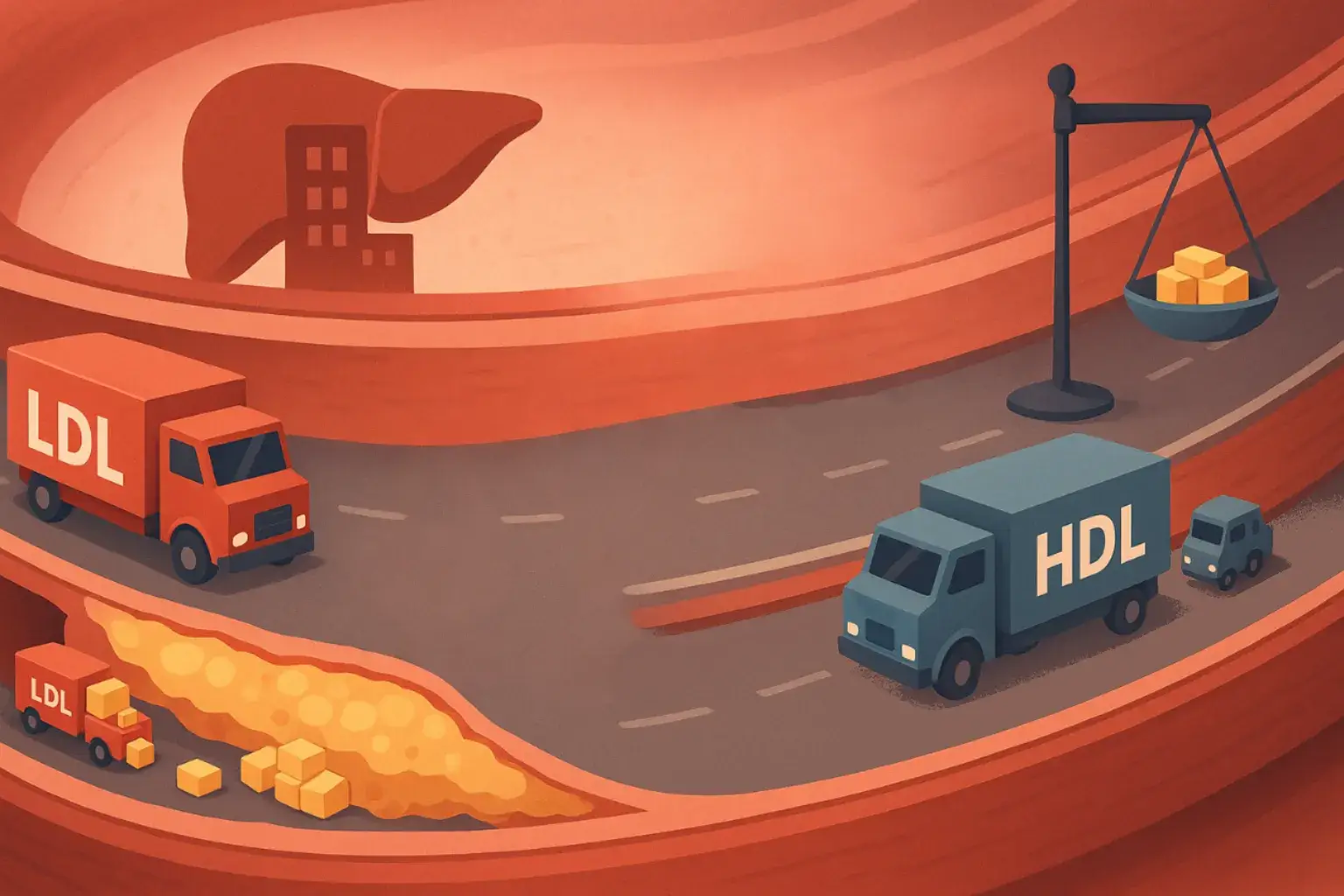
Cholesterol & Arteries: Science-Backed Guide
- Olivia Hart
- Cardiology , Preventive health
- May 28, 2025
Table of Contents
Fast Facts: Cholesterol & Artery Health (TL;DR)
- Cholesterol is Vital: Essential for hormones and cell walls, mainly produced by your liver.
- LDL vs. HDL: LDL (‘bad’) transports cholesterol to tissues; HDL (‘good’) returns it to the liver. High LDL is a risk factor for heart disease.
- Arteriosclerosis Explained: It’s the hardening and narrowing of arteries, not just simple blockage. Inflammation plays a key role.
- Beyond Numbers: Cholesterol levels are a risk factor, but treatment success is measured by preventing events like heart attacks, not just improving numbers.
- Lifestyle Matters: Diet, exercise, and avoiding smoking are crucial in managing cholesterol and preventing arteriosclerosis.
Understanding Cholesterol and Its Journey in Your Body
Cholesterol often gets a bad rap, but it’s a waxy, fat-like substance that’s absolutely essential for life. Your body, primarily your liver, produces most of the cholesterol it needs to build healthy cells, produce vital hormones (like estrogen and testosterone), and synthesize vitamin D [6]. A smaller portion comes from the foods we eat, particularly animal products.
To travel through your bloodstream, cholesterol is packaged into particles called lipoproteins, which consist of lipids (fats) and proteins. The two main types you’ve likely heard about are:
- Low-Density Lipoprotein (LDL) Cholesterol: Often dubbed “bad” cholesterol, LDL transports cholesterol from the liver to cells throughout your body. If you have too much LDL cholesterol, or if it’s not cleared effectively, it can contribute to the buildup of plaque in your arteries [6].
- High-Density Lipoprotein (HDL) Cholesterol: Known as “good” cholesterol, HDL acts like a scavenger, picking up excess cholesterol from your tissues and arteries and returning it to the liver for processing and removal [3], [6].
Think of LDL as the delivery trucks and HDL as the recycling trucks for cholesterol. A healthy balance is key.
Arteriosclerosis: When Arteries Harden and Narrow
High LDL cholesterol levels are a significant risk factor for arteriosclerosis, a condition where your arteries become thick, stiff, and narrowed [7]. This process, often used interchangeably with atherosclerosis (a specific type of arteriosclerosis caused by plaque buildup), doesn’t happen overnight. It’s a slow, progressive disease that can begin in youth and worsen over decades.
It was once thought that cholesterol simply stuck to artery walls like scale in a pipe. However, the science now shows a more complex picture involving chronic inflammation [1]. Here’s a simplified view of how it can develop:
- Initial Damage: The inner lining of an artery (endothelium) can be damaged by factors like high blood pressure, smoking, or high blood sugar.
- LDL Accumulation & Oxidation: LDL particles can enter the damaged artery wall. Once there, they can become modified (oxidized), triggering an inflammatory response.
- Inflammatory Response: Immune cells, particularly macrophages (a type of scavenger cell), are recruited to the site. These cells engulf the modified LDL cholesterol, becoming “foam cells.”
- Plaque Formation: Over time, these foam cells, along with other cellular debris, cholesterol crystals, and calcium, accumulate to form plaques within the artery wall.
- Narrowing and Hardening: As plaques grow, they can thicken and harden the artery wall, narrowing the space for blood flow.
- Complications:
- Reduced Blood Flow: Narrowed arteries can restrict blood flow to vital organs. If this occurs in the coronary arteries (supplying the heart), it can cause chest pain (angina), especially during exertion.
- Plaque Rupture and Blood Clots: Plaques can become unstable and rupture. When this happens, the body perceives an injury and forms a blood clot at the site to “heal” it. This clot can partially or completely block the artery.
- If a clot blocks a coronary artery, it leads to a heart attack.
- If it blocks an artery leading to the brain, it causes a stroke.
While this process can occur in any artery, it’s particularly dangerous in those supplying the heart and brain [7]. It’s important to note that sometimes small clots form and are reabsorbed without immediate, noticeable consequences, but this healing process itself can contribute to further scarring and narrowing over time.
Besides high LDL cholesterol, other factors significantly increase the risk of arteriosclerosis. These include:
- High blood pressure (hypertension)
- Cigarette smoking
- Diabetes (Type 1 and Type 2)
- Obesity
- Lack of physical activity
- Family history of early heart disease
- Chronic inflammatory conditions [1]
- An unhealthy diet high in saturated and trans fats [8]
Current guidelines from organizations like the American Heart Association (AHA) and the American College of Cardiology (ACC) emphasize assessing overall cardiovascular risk based on multiple factors, not just cholesterol [2], [9].
Cholesterol Levels: A Piece of a Larger Puzzle
While elevated LDL cholesterol is a well-established risk factor for cardiovascular diseases [2], [6], it’s crucial to understand that cholesterol numbers alone don’t tell the whole story about treatment effectiveness. Improving your cholesterol profile is beneficial, but the ultimate goal of any intervention is to prevent serious health events like heart attacks, strokes, and the need for procedures like bypass surgery or stenting.
There have been instances where treatments showed promise in altering cholesterol levels but failed to translate into better patient outcomes, or even proved harmful. For example, the drug torcetrapib was very effective at raising HDL (“good”) cholesterol and lowering LDL (“bad”) cholesterol. However, large-scale clinical trials revealed that it actually increased the risk of cardiovascular disease and death, leading to its discontinuation [5] (this specific reference is for canakinumab and inflammation, but the torcetrapib example is a well-known case in lipidology illustrating the point; finding a direct ref for torcetrapib’s failure might be useful but the concept is what’s key).
This highlights why rigorous scientific research, focusing on clinical outcomes (like heart attacks and strokes) rather than just lab values, is paramount. When considering any treatment or lifestyle change, it’s essential to look for evidence that it not only improves numbers but also demonstrably reduces the risk of actual cardiovascular events and improves overall health and longevity [9]. Many sources offer advice on managing high cholesterol, but only some strategies are robustly proven to prevent serious complications [8], [10]. Always consult with healthcare professionals for personalized advice.
Frequently Asked Questions (Q&A)
Q1: What is the main difference between LDL and HDL cholesterol?
Q2: How does high cholesterol contribute to arteriosclerosis?
Q3: Is it true that cholesterol is only bad for you?
Q4: What are the major risk factors for arteriosclerosis besides high cholesterol?
Q5: Can lifestyle changes really help manage cholesterol and prevent arteriosclerosis?
Disclaimer
The information provided on BioBrain is intended for educational purposes only and is grounded in science, common sense, and evidence-based medicine. It is not a substitute for professional medical advice, diagnosis, or treatment. Always consult a qualified healthcare provider before making significant changes to your diet, exercise routine, or overall health plan.
Tags :
- Cholesterol management
- Heart disease prevention
- Ldl vs hdl
- Vascular health
- Lipid metabolism
- Cardiovascular risk factors
- Arteriosclerosis causes
- Preventing artery hardening
- Inflammation and heart disease
